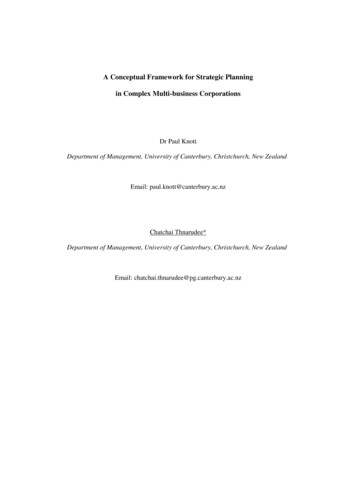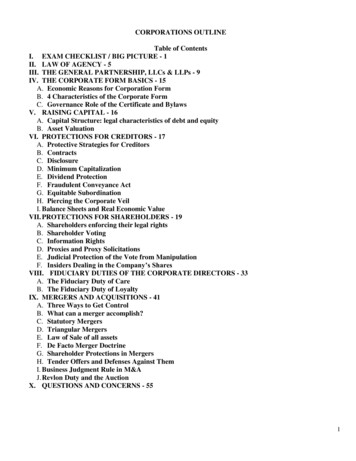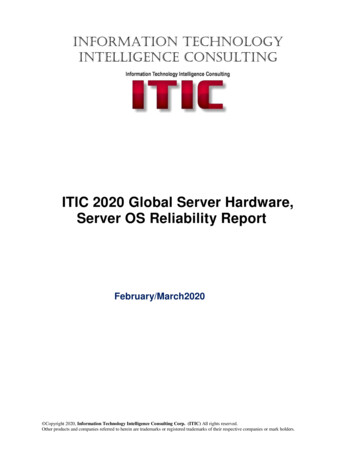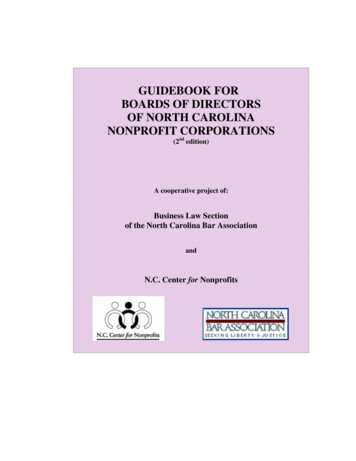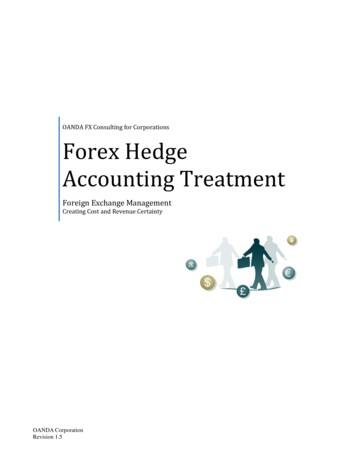
Transcription
OANDA FX Consulting for CorporationsForex HedgeAccounting TreatmentForeign Exchange ManagementCreating Cost and Revenue CertaintyOANDA CorporationRevision 1.5
Forex Hedge Accounting TreatmentOANDA’s FXConsultingfor CorporationsTable of ContentsIntroduction . 3Why Hedge? . 3What Is Hedging?. 3What Is Hedge Accounting? . 3Who Is This Document Intended For? . 4What Are the Steps to Hedge Accounting? . 4Quick Background . 5Types of Forex Hedges . 5Types of Hedged Exposures . 5Documentation and Accounting Overview . 5Summary Table . 6Obtaining Special Accounting Designation for Your Forex Hedges . 8Designated Hedges - US GAAP and IFRS Considerations . 8Types of Hedged Exposures . 10Recorded Financial Asset or Liability (known or translation risk) . 10Firm Commitments – Fair Value or Cash Flow Hedge .11Firm Commitment Accounting Scenario (Cash Flow vs. Fair Value Hedge) .11Highly Probable Forecasted Forex Transactions (Transaction Risk – Cash Flow Hedge) . 13What Happens When a Highly Probable Foreign Transaction Ceases to be Highly Probable? . 14Net Investment in Foreign Operation – Investment Risk . 14Documenting Designated Hedging Criteria . 15Accounting Standards . 15Organizational Requirements . 15Conclusion . 16Other Issues . 17Forex Options . 17Accounting Ramifications for Forex Options . 17Speculative Trading. 18Additional Complexity. 18Disclaimer . 19Case Study #1- Economic Forex Hedge – Not Designated – Accounting Entries . 20Case Study #2 - Cash Flow Hedge – Designated – Accounting Entries . 24Appendix A – Concepts and Terms . 29Accounting Currency Types . 29Risks . 29Types of Forex Hedges . 29Foreign Currency Exposures . 30Hedge Testing. 31Appendix B – What to Hedge? . 32Data Capture: The Key to Determining How Much to Hedge. 32Capturing Data on Recorded Assets and Liabilities. 32Capturing Data on Firm Commitments. 32Capturing Data on Forecasted Transactions. 33Forex Hedging Ratios . 33Natural Hedges . 34Appendix C – Forex Hedge Summary Table . 35-2-
Forex Hedge Accounting TreatmentOANDA’s FXConsultingfor CorporationsIntroductionWhy Hedge?Tapping into the global economy can be an effective way to expand your business. However, thesuccess of your company’s international business is tied to foreign exchange rate volatility, withconstant rate fluctuations contributing to unexpected profits or losses. Forex hedging is meant to reducethe risk associated with a company’s exposure to foreign currency balances and transactions. It is inyour company’s best interests to recognize these risks and formulate a hedging strategy to safeguardagainst currency fluctuations, thereby creating cost and revenue certainty for your foreign currencytransactions.What Is Hedging?Basic Concept: The forex hedge’s change in value is opposite to the change in value of the foreigncurrency exposure (hedged item). These two amounts offset each other to obtain cost certainty orrevenue certainty.FMV of ForexHedgeFMV ofHedged ItemAll forex hedges are recorded on the balance sheet attheir fair market value (FMV).The items recorded on the other side of the journal entrydepend on whether a forex hedge was designated forspecial accounting treatment (provided it met applicablecriteria).What Is Hedge Accounting?Hedge accounting is a privilege, not a right. It is special accounting treatment for designated hedgesthat meet the required criteria outlined in the accounting standards.In typical accounting treatment, forex hedges are carried on the balance sheet at their fair market value,with any changes in the carrying value impacting the income statement in each reporting period.Sometimes this typical treatment creates a timing mismatch in terms of when the forex hedge impactsearnings and when the hedged item impacts earnings. Forex hedge accounting, on the other hand,overrides this method of recording the impact on earnings in the reporting period because the gain/lossof the hedged items and the gain/loss of the forex hedge are recorded in earnings at the same time. Inthis way, hedge accounting reduces the earnings volatility caused by changes in foreign currency rates.Forex hedging accounting treatment can be relatively easy or very complex, depending on the nature ofyour company’s forex activities and its hedging products. In general, the fair market value of foreigncurrency hedges is recorded, often referred to as the "mark-to-market" position (the value of the forexhedge as at the financial reporting date). With forex carry spot hedges, the mark-to-market informationis readily available. However, the more challenging component of recording the mark-to-market valueis deciding how to record the other side of the journal entry. Some of the key standards related to forexhedge accounting include:International Accounting Standard 39 (IAS 39), Financial Instruments: Recognition andMeasurementFinancial Accounting Standard 133 (FAS 133), Accounting for Derivative Instruments andHedging Activities (United States)-3-
Forex Hedge Accounting TreatmentOANDA’s FXConsultingfor CorporationsWho Is This Document Intended For?CFOs, vice-presidents of finance, treasurers, controllers, and accountants can use this document to gaina basic understanding of hedge accounting.What Are the Steps to Hedge Accounting?The first step in the process is deciding whether to hedge your company’s exposure to foreign currencybalances and transactions.1) Hedging - Yesor No?2) What toHedge?3) Forex HedgePlan4) HedgeAccountingAssess forex risk vs.costData captureprocess- Find a forex hedgesupplier- Design your internalcontrols and processes- Enter forex hedge(designated or notdesignated)- Meet Criteria- Documentation &Testing- Fair Market Value- Not Designated (P&L)- Designated - SpecialAccountingIf yes, then.- Develop Forex HedgingPolicy- Educate staff- Recorded balance sheetforeign currency amounts- Forecasted future forextransactions1. Your company needs to assess its forex risk related to how much foreign currency exposure ithas on the current balance sheet and on expected future transactions.2. If your forex exposure exceeds your company’s appetite for risk, then you will need to build aprocess for data capture. Each company will need to capture and validate its foreign currencyexposures to enable effective forex hedging for managing its foreign currency risk. For adiscussion, please see Appendix B – What to Hedge?.3. While determining what to hedge (or after), you will need to create and implement processesand procedures to manage forex hedging and its special accounting treatment, includingobtaining fair market values at each reporting period.4. You require upfront documentation to designate a hedge for special accounting treatment.Throughout the life of the designated hedge, the accounting standards require ongoingeffectiveness testing and adequate accounting systems to manage tracking when the hedgeditem impacts earnings in order to release the forex hedge’s gain or loss to earnings.-4-
Forex Hedge Accounting TreatmentOANDA’s FXConsultingfor CorporationsQuick BackgroundTypes of Forex HedgesAll economic hedges aim to manage foreign currency exposure, meaning they are undertaken for theeconomic aim of reducing potential loss from fluctuations in foreign exchange rates. However, not allhedges are designated for special accounting treatment. Accounting standards enable hedge accountingfor three different designated forex hedges:A cash flow hedge may be designated for a highly probable forecasted transaction, a firmcommitment (not recorded on the balance sheet), foreign currency cash flows of a recognizedasset or liability, or a forecasted intercompany transaction.A fair value hedge may be designated for a firm commitment (not recorded) or foreigncurrency cash flows of a recognized asset or liability.A net investment hedge may be designated for the net investment in a foreign operation.Types of Hedged ExposuresPrior to initiating a forex hedge and designating the hedge for special accounting treatment, you willneed to capture and evaluate data on the foreign currency exposure, which typically falls into thefollowing categories:foreign currency cash flows of a recognized asset or liability (recorded on the balance sheet),a firm commitment (not recorded on the balance sheet),a highly probable forecasted foreign currency transaction,a forecasted foreign currency intercompany transaction, orthe net investment in a foreign operation.A summary table of the types of hedged exposures and the applicable forex hedges follows. Each hasits own accounting treatment, which will be discussed later in the document.Hedged ExposuresRecorded asset orliabilityFirm commitmentEconomic ForexHedge*Fair ValueHedgeCash FlowHedgeNet InvestmentHedgeYes - CommonYesYesn/a*Yes – purchaseor saleYes - purchaseor salen/aForecasted highly*n/aYesn/aprobable transactionNet investment in*n/an/aYesforeign operations*An economic forex hedge may be used in any scenario; however, it will not necessarily achieve thedesired accounting treatment and it may, in fact, create volatility in earnings.Documentation and Accounting OverviewBefore a company can designate a forex hedge as one that qualifies for the special hedge accounting,specific criteria must be met and documented. While each forex accounting hedge (cash flow, fairvalue, or investment) has unique accounting treatment, the guiding principle is the recognition of thegain/loss of the hedged items and the gain/loss of the forex hedge into earnings at the same time. Thatis, the effective portion of the forex hedge’s gain/loss is recognized simultaneously on the income-5-
Forex Hedge Accounting TreatmentOANDA’s FXConsultingfor Corporationsstatement as the gains/losses from the hedged foreign currency item.The ineffective portion of a forex hedge’s change in value (for example, over-hedged amounts orinterest carrying costs) must be recognized immediately in earnings. Similarly, any forex hedge thatdoes not meet the criteria for designation or is not designated as a cash flow, fair value, or netinvestment hedge has its change in fair market value recognized immediately in earnings.Proper documentation is critical to achieving hedge accounting treatment and must be supplied up frontbefore a hedge is initiated. Further, prospective and retrospective assessments of a forex hedge musttake place over its lifetime to ensure the hedge is effective. As noted previously, any ineffective portionof a forex hedge is recorded directly to the income statement.The right to perform special hedge accounting for designated forex hedges must be earned by meetingthe required criteria and documentation requirements. It is not an automatic right.Summary TableThe table on the following page offers a high-level summary of forex hedges, journal entries, and theirimpacts to earnings.-6-
Forex Hedge Accounting TreatmentBreakdown of Forex HedgesOANDA’s FXConsulting for CorporationsJournal EntriesEarnings Impact(effective portion of hedge)Non Designated Gain/loss on forex hedge recorded directly to P&L Gain/loss on forex hedged item recorded directly to P&Li.e. Recorded foreign currencyassets/liabilitiesDesignated - Fair Value Hedgei.e. Firm purchase commitmentsDesignated - Cash Flow Hedgei.e. Firm sales commitments andhighly probable forecasted transactionsDesignated - Net Investment HedgeNet investment in a foreign Gain/loss on forex hedge recorded directly to P&L Gain/loss on firm commitment recorded directly to P&L with firmcommitment's change in value recorded on the balance sheet When purchase transaction is completed, the firm commitment'svalue reclassified to the asset Gain/loss on forex hedge recorded to equity OCI account Gain/loss on future forex hedged item is not recorded until thehedged transaction is completed Other Comprehensive Income ("OCI") amount reclassified to earningswhen hedged item impacts earnings Gain/loss on forex hedge recorded to equity OCI account Consolidation of foreign subsidiary has its translation gains/lossesrecorded to equity OCI accountEffective amounts offset each otheron earnings.Effective amounts offset each otheron earnings.Inventory amounts or capital assetsare directly adjusted for gains/losseson forex hedge.Effective amounts offset each otheron earnings.Hedged item’s impact to earningsmust be tracked to reclassify OCIamounts at same time.Effective amounts offset each otherin the equity OCI account.currency subsidiaryThe ineffective portion of a forex hedge, as defined by accounting criteria, is recorded to earnings immediately.Other forex hedge designations:1. Fair value hedges may be designated for firm sales commitments. Similar impact as hedging a firm purchase commitment.2. Cash flow hedges may be designated for firm purchase commitments; however, the reclassification of the OCI amounts to earnings to match the timing ofthe hedged item’s impact to earnings may be more challenging.3. While not typical, both cash flow hedges and fair value hedges may be designated for certain recorded foreign currency assets and liabilities. For example,foreign denominated debt.7
Forex Hedge Accounting TreatmentOANDA’s FXConsultingfor CorporationsObtaining Special Accounting Designation for Your Forex HedgesHedge accounting is not an automatic right; it must be earned.Once you have gathered your foreign currency exposure data, you then have to determine what forexhedge product will be used and whether the forex hedge will be designated for special accountingtreatment. For our discussion, we will use a carry spot forex hedge; however, a forex forward contractcould have been used as well. (In the two case studies at the end of this document, we detail the variousaccounting entries for a recorded foreign asset and a future firm commitment.)To recap, the following hedges can be designated for special accounting treatment:A cash flow hedge may be designated for a highly probable forecasted transaction, a firmcommitment (not recorded on the balance sheet), foreign currency cash flows of a recognizedasset or liability, or a forecasted intercompany transaction.A fair value hedge may be designated for a firm commitment (not recorded) or foreigncurrency cash flows of a recognized asset or liability.A net investment hedge may be designated for the net investment in a foreign operation.An economic forex hedge is not designated for special accounting treatment. The economic hedgewould protect your economic position over time, but it may create earnings volatility. An economicforex hedge may be used to hedge any item; however, all the gains/losses on the hedge are immediatelyrecorded into earnings.Designated Hedges - US GAAP and IFRS ConsiderationsThe ultimate goal for designated forex hedges is to record the effective portion of the gains or losseswhen the hedged item impacts earnings. The accounting treatment under IFRS, US GAAP, andCanadian GAAP is similar and depends on what you are hedging, and in which of the followingcategories it falls:Cash flow hedges manage transaction risks.Cash flow hedges are instruments that hedge the variability of anticipated future foreign cashflows from a highly probable forecasted transaction, firm commitments, recorded assets, andliabilities. For example, the forex hedge's change in value will offset the change in value of asigned foreign sales contract when that contract is delivered in the future.Cash flow hedges are used to hedge the variability of anticipated future foreign cash flows byalways converting the cash flow to a fixed amount. For example, a cash flow forex hedgewould not be applicable for foreign-denominated variable interest rate debt, since the interestvariability would not be fixed. (A foreign interest rate swap—receive variable, pay fixed—could be used instead to hedge foreign-denominated variable interest rate debt.)Note that a cash flow forex hedge could be used for foreign currency purchases or sales becausethe forex hedge would convert the variability of the amount paid or received in the foreigncurrency to a fixed amount in the reporting currency. As noted earlier, the effective portion of8
Forex Hedge Accounting TreatmentOANDA’s FXConsultingfor Corporationsthe gain or loss on cash flow forex hedges will be recorded into the OCI account and theamount will be reclassified to earnings when the gain or loss on the hedged item impactsearnings. Note, the determination and the tracking of when to release the OCI amount toearnings for purchase commitments may become quite complex as the hedged item’s impact toearnings may occur over an extended time, (for example, raw materials purchases that are usedin a variety of finished products would impact earnings, only when the finished product hasbeen sold to third parties).The change in foreign sales value, when converted to the reporting currency, will be offset bythe cumulative change in value of the forex hedge, assuming that a hedging relationship isdocumented and proven. If the cash flow hedge is not documented or not effective (outside aneffective range of 80% to 125%) then changes in the forex hedge's value will flow throughearnings. Consult your auditor on acceptable hedging effectiveness ranges and methods forproving their success.Fair value hedges manage translation and transaction risks.Fair value hedges are instruments that hedge the value of an asset or a liability recorded on thebalance sheet, or the value of a firm commitment. Therefore, changes in the value of the forexhedge occur opposite on the balance sheet to changes in the value of the recordedasset/liability or firm commitment.A cash flow forex hedge has its gains and losses recorded in the OCI account and the amountsare subsequently reclassified to earnings when the hedged item impacts earnings, whereas, thegains and losses for a fair value forex hedge will be recorded in a manner that directly impactsthe hedged item. For example, the hedged inventory purchase will have the inventorycommitment recorded on the balance sheet prior to the receipt of the inventory. This inventorycommitment value (change in fair market value of the firm commitment) will be reclassifieddirectly to the inventory account, when the inventory is received. No additional tracking wouldbe required to determine when the inventory eventually impacts earnings as part of cost ofgoods sold.(See the Firm Commitments example on page 11 to compare the balance sheets for a purchasecommitment hedged with a cash flow hedge vs. a fair value hedge.)Net investment hedges manage investment risks.A net investment hedge is designed to minimize the foreign exchange effect on foreigninvestment. In this case, a change in the value of the net foreign assets/liabilities is adjusted tothe OCI foreign exchange translation account, which is offset by the change in value of theforex hedge.For designated forex hedges, the hedge contract must be with a third party supplier. Typically, eachdesignated forex hedge will be a separate contract. However, there are some circumstances where aseries of internal hedge transactions entered into between a parent company of a consolidated groupand its subsidiaries will qualify as hedging instruments, if those internal hedges are offset to third-partyhedging contracts (even if the third-party contract is completed on a net basis).9
Forex Hedge Accounting TreatmentOANDA’s FXConsultingfor CorporationsTypes of Hedged ExposuresThe types of foreign currency exposures typically fall into the following categories:Foreign currency cash flows of a recognized asset or liability recorded on the balance sheetFirm commitments (not recorded on the balance sheet)Highly probable forecasted foreign currency transactionsForecasted foreign currency intercompany transactionsNet investments in a foreign operationThe hedging options for most of these hedging exposures are covered below.Recorded Financial Asset or Liability (known or translation risk)Not designated for special accounting treatmentSince most recorded financial assets and liabilities are revalued at each reporting date, an undesignatedeconomic forex hedge is an efficient mechanism for managing this foreign currency exposure. If theitem to be hedged relates to a recorded financial asset or financial liabilities (for example, accountsreceivable or accounts payable), then the change in the fair value of the hedge will be recorded as aforeign exchange gain/loss on the income statement. The resulting change in the financial asset/liabilitywill also be recorded as a foreign exchange gain/loss on the income statement. There is no need forspecial hedge accounting since the gains and losses on the hedge and the hedged item will offset eachother on the income statement.The benefits of not designating the hedge for special accounting treatment include no upfrontdocumentation, no required ongoing testing (although hedge effectiveness testing is a prudentmeasure), and the foreign exchange position may be managed on a net basis (lowering the hedgetransaction costs). Disadvantages may occur when the hedged item impacts earnings differently fromwhen the forex hedge impacts earnings. For example, available-for-sale financial assets will have theirchanges in carrying amounts recorded in equity, which would create a mismatch in earnings timing, ifthe forex hedge was not designated.Based on how well the hedged item and the forex hedge are effectively matched, the changes incarrying value would offset each other. The net amount on the income statement, therefore, representsthe inefficiency of the hedging relationship or the portion of the asset/liability that was not hedged. Inthe latter part of this document, the first case study documents the accounting entries related to aneconomic forex hedge and the related financial asset when no designation has occurred.Designated for special accounting treatmentThe accounting standards allow either a fair value hedge or a cash flow hedge to be used to hedgerecorded foreign currency assets and liabilities. The flexibility for the hedge designations allowsflexibility for a company to manage its foreign-denominated debt (for example, converting a variablerate foreign debt into variable rate functional currency debt or converting a variable rate foreign debtinto fixed rate functional debt). Under the definition of a cash flow hedge, the hedge locks in the futurecash flow amounts. Therefore, the cash flow hedge of a foreign variable rate debt would need to hedgenot only the forex exposure but also convert the variable interest rate to a fixed interest rate. However,a fair value hedge of a foreign variable rate debt would need to hedge only the forex exposure andmaintain the exposure to variable interest rates.10
Forex Hedge Accounting TreatmentOANDA’s FXConsultingfor CorporationsThe benefit of designating the hedge for special accounting treatment is removing the volatility on theincome statement, since effective portion of the forex hedge impacts earnings when the hedged itemimpacts earnings. The disadvantage of designating the hedge for special accounting treatment is theextra effort required for documentation, testing, and managing the information when the hedged itemimpacts earning in order for the designated forex hedge to impact earnings at the same time. Bothdesignated and non-designated forex hedges reduce potential loss from fluctuations in foreign exchangerates over time.Firm Commitments – Fair Value or Cash Flow HedgeThe accounting treatment under IFRS, US GAAP, and Canadian GAAP allows either a cash flow hedgeor a fair value hedge to be designated for foreign currency firm commitment. A firm commitment is abinding contract with an unrelated third party that specifies the quantity, price, and timeframe for thetransaction (see Appendix A – Concepts and Terms). The ability to use either a cash flow hedge or a fairvalue hedge is useful as each transaction will create the same impact to earnings (opposite the impactof the hedged item); however, the accounting entries will be different.The gain or loss on cash flow forex hedges will be recorded in the OCI account and the amount will bereclassified to earnings when the gain or loss on the hedged item impacts earnings. For certaintransactions, tracking the impact to earnings by the hedged item may be challenging.The gain or loss on fair value forex hedges will be recorded directly to earnings; however, the fairvalue of the hedged item will be adjusted at the same time. Similarly, the gain or loss on the designatedhedged item will be adjusted to earnings at the same time. Typically, the effective portion of the fairvalue hedge recorded to earnings will be offset by the change in value of the hedged item. For example,the change in value of the hedged firm purchase commitment is recorded on the balance sheet as apurchase commitment. This value is opposite to the fair market value of the forex hedge. The change invalue of hedged purchase commitments is recorded on the balance sheet.These commitments or their change in value are not typically recorded on the balance sheet (onlydisclosed in the financial statement notes). However, since the firm commitments are part of adesignated fair value hedge, the change in commitment value is recorded on the balance sheet. Whilethis may sound confusing, it can be demonstrated in the Firm Commitment Accounting Scenario below.Firm Commitment Accounting Scenario (Cash Flow vs. Fair Value Hedge)The accounting treatment is better illustrated through the use of an example since the jour
Forex Hedge Accounting Treatment OANDA’s FXConsulting for Corporations - 6 - statement as the gains/losses from the hedged foreign currency item. The ineffective portion of a forex hedge’s change in value (for example, over-hedged amounts or interest ca




